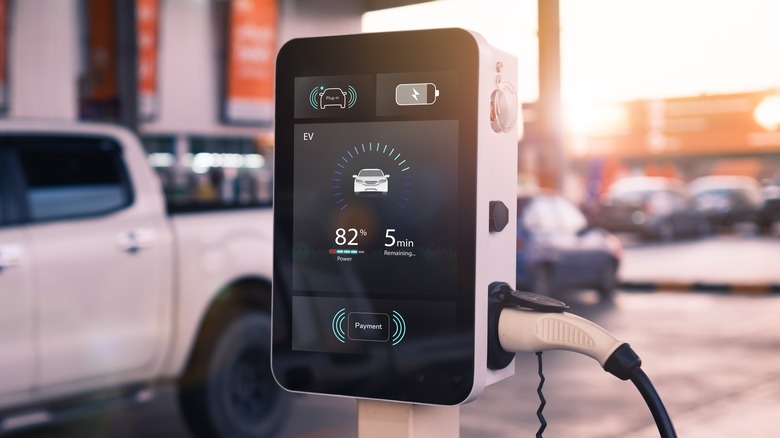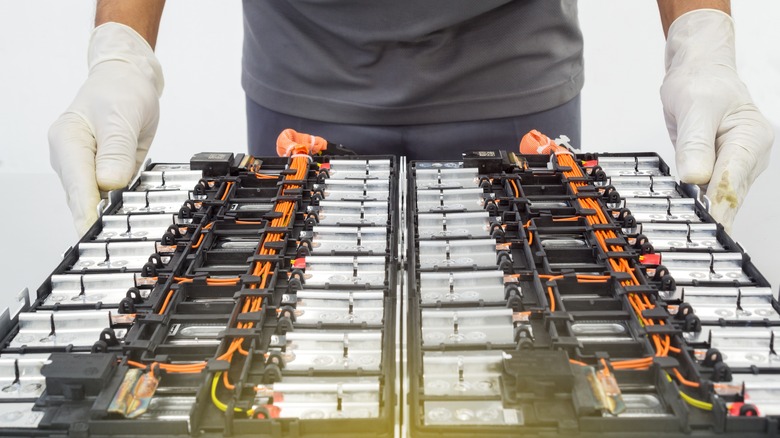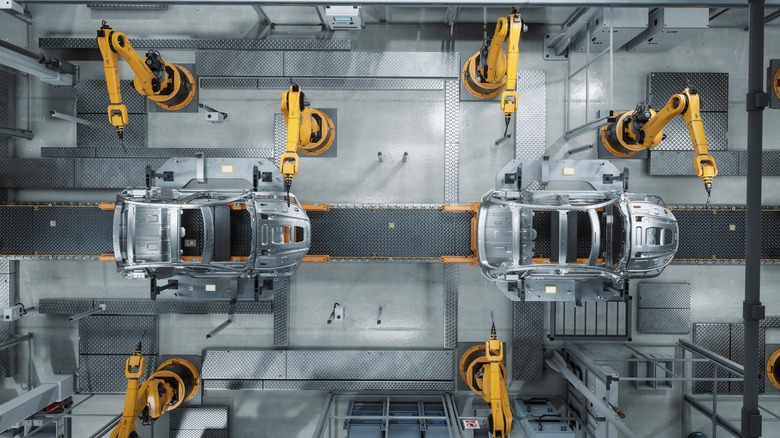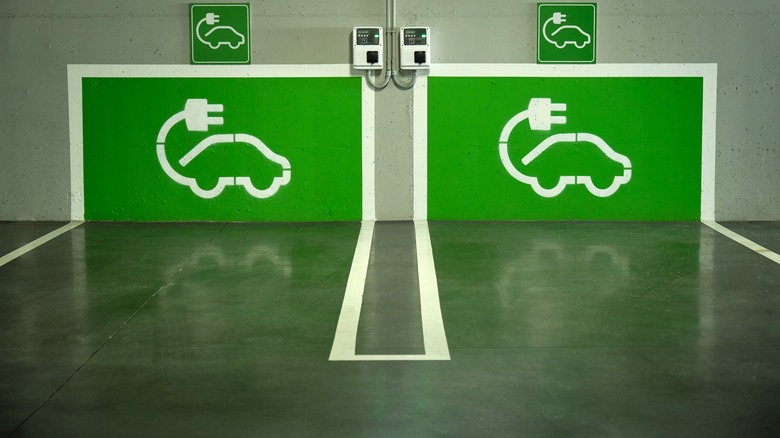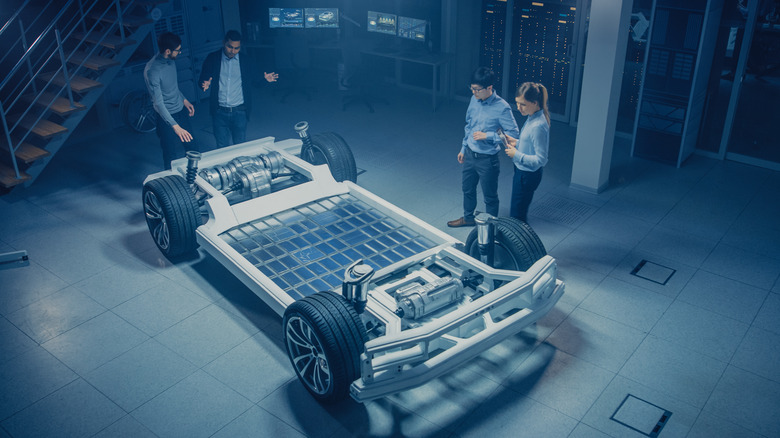How Many Miles Before An Electric Car Is Greener Than A Gas Car
Electric vehicles have often been hailed as the future. Major motoring companies are aiming to produce nothing but electric vehicles in the future, and some aspire to hit that target by the end of the decade. Cars that are traditionally seen as so-called gas guzzlers — like pickup trucks, muscle cars, and hummers — all have electric equivalents. Governments, including the one running the United States, are improving infrastructure, offering tax incentives, and enacting policies aimed at getting more electric vehicles on the road. And modern-day industrial icons like Elon Musk, who obviously has a vested interest in the electric car's success, constantly promote the concept. Musk recently published a tweet that likened internal combustion engines to the steam engine — an archaic method of producing mechanical power.
Won’t be long before we view gasoline cars the same way we view steam engines today
— Elon Musk (@elonmusk) September 12, 2022
Although some alternatives are available, electric cars are by far the most practical carbon-neutral methods of personal transport as things stand. Over its lifetime, an electric car will have significantly less impact on the environment than its gasoline equivalent. But EVs aren't exactly green from the get-go. At the moment they roll off the production line, that carbon-neutral electric car has actually contributed more to climate change than a gas-powered vehicle that could be produced in the same factory. Depending on where you live, this deficit can also take a while to overturn.
The batteries don't just appear from thin air
An electric vehicle's battery doesn't grow on trees and is far more complex than the lead-acid battery spinning a gas car's starter motor. The newer type of vehicle uses lithium-ion batteries, as noted by the U.S. Department of Energy, which as the name suggests, contain an element called lithium, among other things. Lithium is a metal that is present on several continents, with the biggest producers including Australia, Chile, and China. The element makes up around 11% of a lithium battery, and those batteries are found in EVs as well as many modern gadgets like phones, tablets, and laptops. In terms of direct environmental impact, lithium mining has been linked to droughts, though scientists are still investigating if it is to blame for water shortages in places like Chile. Another material involved in battery production is cobalt, most of which is mined in the Democratic Republic of Congo.
Alongside the emissions and local pollution produced by the mining process, there is also a problem with transportation. All of these materials have to be shipped to China, which produces the vast majority of EV batteries before those very heavy batteries are shipped to car manufacturing plants around the world. All in all, battery production accounts for up to three-quarters of the energy used and up to 70% of emissions produced in an electric vehicle's production (via AAA).
Vehicle production is energy intensive anyway
Manufacturing a car is a very energy-intensive process. The raw materials involved — mainly steel and aluminum — require a lot of energy to produce and like the finished batteries, they have to be shipped to the factories where the cars are actually made. From there, the raw materials are stamped, forged, and cut into parts before being welded and bolted together. Rare earth materials, similar to some of those used in batteries, can also be found in a car's many electrical parts. In short, manufacturing a vehicle is a highly energy-intensive process. National Geographic estimates as much as 20% of a car's total emissions will be produced while it is being manufactured.
Things look a bit better in raw energy terms. If you want to put things in motoring terms, MotorBiscuit estimates that at best the energy used to produce an average car is roughly 56,880 Megajoules — which translates to around 474 gallons of gas. This is enough to fill the average fuel tank around 31 times. So, in theory, if you buy a used car instead of a new Tesla, you can burn through your next 31 tanks of gas guilt-free and still be ahead due to the energy used to make the EV's batteries. Beyond that, things will depend on the electric vehicle's actual fuel source.
Where does the power come from?
Despite their surging popularity, electric vehicles still have many detractors. One statement those detractors like to make involves the actual source of the energy electric vehicles use to get around. The outlet you're plugging your EV into isn't producing any power, it's just supplying it. Where the electricity charging your batteries comes from is different, depending on where you live. If you live in Iceland, you have the right to be a bit smug from an environmental perspective. The Icelandic government claims that almost all of the power the country uses comes from renewable sources. Geothermal power, which is quite easy to tap into on the highly volcanic island, makes up the majority of that.
Across the Atlantic, things are a bit different. Fossil fuels are used to generate over 60% of the United States' energy, with natural gas being used to generate over 38%. The U.S. Energy Information Administration also says coal is used to meet over one-fifth of American energy needs. Nuclear power, which generates no greenhouse gases, also accounts for nearly 20% of the power generated in the United States. Nuclear energy has a mixed reputation amongst environmental groups, with some seeing it as the most practical clean energy solution, while others are adamant that the nuclear waste produced is not worth the supposed green benefits. Renewable energy makes up around 20% of energy production overall, with around half of that being generated from wind. These are totals for the U.S. as a whole, and energy sources vary by state — with Vermont being the cleanest and Delaware being considered the dirtiest, at least in the energy sense of the word (via Big Think).
How long until an electric vehicle becomes truly green?
According to research from the Fuel Institute, you may need to drive your electric vehicle for a couple of years before you can claim you're doing less harm to the planet than someone with a gas-powered car. In the best-case scenario, when the electric vehicle is being driven in a state where most of the energy comes from low-carbon sources, it will take 19,000 miles before the EV becomes more climate-friendly than an internal combustion engine.
However, once the carbon deficit the EV built up during its manufacturing is overcome, it becomes far more efficient than its fossil fuel-powered equivalent. Again, in a best-case scenario, a battery-powered electric vehicle will have produced 41% fewer emissions after 200,000 miles when compared to a vehicle with an internal combustion engine.
What about hybrids?
Hybrids also start with a deficit but do better than traditional automobiles in the long run. A hybrid will have to be driven far more than 19,000 miles before its owner can accurately claim it has had less of an impact on the environment than its traditional equivalent. After 200,000 miles, which is a reasonable lifespan for most cars, it will have been responsible for 28% less CO2 than a similarly specced gas-powered car.
Although they have been around for a while and have recently surged in popularity, there is a fair argument that we're still in the early days of an electric vehicle golden age. The vehicles themselves are likely to get more efficient over the years, and the infrastructure that supports them will also improve. The time it takes for your EV to be more climate-friendly than an ICE, and its overall lifetime emissions will plummet as renewable energy projects develop.
Battery production may become greener, too
Outside of the batteries, electric vehicles are manufactured in essentially the same way as standard vehicles, so most of the emissions deficit is caused by the energy it takes to make the batteries that EVs rely on. Manufacturers and governments are aware of this and are doing what they can to make the process a bit greener. Although it was poorly implemented, it's obvious to see what the U.S. government was trying to do with the EV tax credit scheme that was bundled in with the inflation reduction act. The credits are now tied to where the vehicle's batteries are produced and the origins of the materials used in the production process.
For a vehicle to qualify for the new tax credit, its batteries must be manufactured in the United States, and 40% of the materials used in the batteries have to be sourced from North America or from a country with which the United States has a free trade agreement. Meeting both conditions makes an electric sedan retailing for up to $55,000 — or any other electric vehicle priced up to $80,000 — eligible for a tax credit of up to $7,500. Meeting one of the conditions will only net the buyer half that amount.
However, it is safe to say that qualifying sources will adapt to meet new orders. Certain companies like Tesla and GM are already well placed to manufacture batteries in the U.S., too. While mining the rare-earth metals batteries need may still be an issue, not shipping materials across the pacific and heavy batteries back will save a lot of CO2. Advances in battery technology, supply chain efforts, and battery recycling programs could lead to electric vehicle production becoming a lot greener in the near future.
Most countries are looking at alternative energy sources
Globally, renewable energy accounts for just under 40% of all electricity produced, depending on whose numbers you look at – and this number is only going to grow. In an attempt to fight climate change, the U.N. has set out some ambitious targets that should keep global warming to a minimum if they are met. Things will still get warmer and the weather may get more extreme, but humanity may be spared the worst consequences of a rabidly heating planet. Those consequences could include coastal cities becoming non-mythical replicas of Atlantis, long droughts leading to widespread crop failures, wildfires, and large portions of the planet becoming uninhabitable. Governments have pledged to meet emissions targets through international agreements like the Paris Climate Accord, and most major companies are setting their own green energy goals.
Those targets are unlikely to be met without a shift toward renewable energy sources, with wind and solar both being popular choices. Some of the projects are highly ambitious and could see the equivalent of 10,000 homes powered by wind energy alone by 2030. Advances in energy storage will also lead to an increase in the viability of renewable energy. We can make predictions related to the amount of time the sun will be visible or the amount of wind an area will get, but we can't control those things. The ability to store excess energy during summer, or when the wind is blowing, then use that energy to balance out seasons with less daylight or days where you barely get a breeze, could take renewable energy to the next level. Whatever happens, it's clear that as the global energy supply becomes cleaner, EVs will be cleaner, too.
